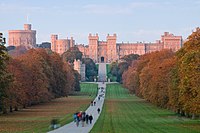English: A view of the British troops, under the command of Lieutenant-General Sir Ralph Abercromby of Tullibody (1734-1801), landing in Holland on 27 August 1799. French Revolutionary Wars (1792-1802): Anglo-Russian invasion of Holland (1799).
This exercise was part of the Anglo-Russian expedition to Holland (also known as the Helder Expedition), a campaign which lasted from the landing of the British troops, shown in this view, on 27 August 1799, to 19 November 1799. The objective was to neutralise the Batavian fleet and to promote a local uprising against the Batavian government.
The name of Keick Down, which appears in the title of this print, probably refers to the dunes known as 'Kijkduin' (52°57'00"N 04°43'00"E), about 10 km (6.2 miles) north-east of the actual landing place at Callantsoog. The view is taken looking south-west, with the grassed dunes of the Dutch coastline seen rising from the beach. The fierce weather during the previous week had prevented the British fleet from making landfall and, even though it had abated sufficiently to allow the troops to land, the strength of the westerly winds can be seen, in the view, in the rough seas and the pennants and flags extended horizontally from the masts of the ships, and on the standards or colours which are being carried over the dunes.
In the left foreground stand the two commanding officers; on the left is Sir Ralph Abercromby, and to his left, pointing out to sea, is possibly Vice-Admiral Sir Andrew Mitchell (1757-1806), to whom this print is dedicated, who had the charge of the transports for the expedition. It is also possible that the naval figure might be Admiral Adam Duncan, 1st Viscount Duncan of Camperdown (1731-1804), who had joined the fleet the previous week and supervised the disembarkation of the troops. In the centre foreground, a couple of sailors are using a windlass to raise the barrel of the cannon onto the gun carriage.
One of a pair of aquatints by Robert Dodd; the companion print is at RCIN 735079. Parker does not give the year of publication which is 1800, as recorded in the imprint.
George III catalogue entry: Texel Vice Admiral Sir Andrew Mitchell taking possession of the whole of the Dutch Ships of War in the Texel on the 30.th of August 1799: by R. Dodd, 1800.
George III catalogue entry: Holland View of the second Division of the British Army commanded by Sir Ralph Abercromby landing on the Beach near Keick Down in Holland on the 27.th of August 1799; covered by the Fleet and Gun Vessels under the command of Vice Admiral Mitchell: by R. Dodd, 1800.




